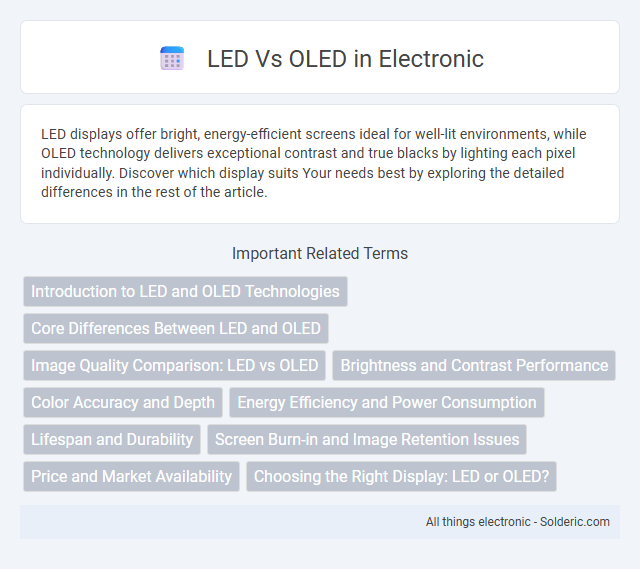LED displays offer bright, energy-efficient screens ideal for well-lit environments, while OLED technology delivers exceptional contrast and true blacks by lighting each pixel individually. Discover which display suits Your needs best by exploring the detailed differences in the rest of the article.
Comparison Table
| Feature | LED | OLED |
|---|---|---|
| Technology | Light Emitting Diode backlighting with LCD panel | Organic Light Emitting Diode pixels emit own light |
| Black Levels | Limited, backlight can bleed | True deep blacks, pixels off completely |
| Contrast Ratio | Up to 1,000:1 | Infinite contrast ratio |
| Color Accuracy | Good, depends on panel type | Excellent, vibrant & accurate colors |
| Viewing Angles | Limited, color shift at angles | Wide viewing angles, no color distortion |
| Brightness | Higher peak brightness | Moderate peak brightness |
| Response Time | Slower, behind OLED | Fastest response time |
| Power Consumption | Higher power for bright scenes | Lower power for dark scenes |
| Lifespan | Longer lifespan | Potential burn-in risk, shorter lifespan |
| Cost | More affordable | Premium price |
Introduction to LED and OLED Technologies
LED technology utilizes light-emitting diodes to backlight LCD panels, providing energy-efficient brightness and color contrast. OLED displays consist of organic compounds that emit light independently when an electric current passes through, enabling true blacks and superior viewing angles. Both technologies offer distinct advantages in screen performance, with LED excelling in longevity and brightness, while OLED delivers richer colors and thinner panel designs.
Core Differences Between LED and OLED
LED displays use a backlight to illuminate liquid crystal pixels, whereas OLED screens have self-emissive pixels that produce light individually. OLED technology offers superior contrast ratios and deeper blacks due to its ability to turn off individual pixels, unlike LED which relies on backlighting that can cause light bleed. Furthermore, OLED panels provide better viewing angles and faster response times compared to traditional LED displays.
Image Quality Comparison: LED vs OLED
OLED displays offer superior image quality compared to LED screens, delivering deeper blacks and higher contrast ratios due to their self-emissive pixels that can turn off individually. LED screens rely on backlighting, which often causes light bleed and less precise color accuracy, resulting in lower contrast and less vibrant images. The ability of OLED technology to produce perfect blacks and more vivid colors significantly enhances overall picture clarity and realism.
Brightness and Contrast Performance
LED displays typically offer higher peak brightness levels, making them ideal for well-lit environments where screen visibility is crucial. OLED panels deliver superior contrast performance due to their ability to turn individual pixels completely off, resulting in true blacks and infinite contrast ratios. This pixel-level control enhances image depth and color accuracy, especially in dark scenes and high dynamic range content.
Color Accuracy and Depth
OLED technology delivers superior color accuracy and deeper blacks compared to LED displays, thanks to its self-emissive pixels that allow precise control over light and color. LED screens rely on backlighting, which can cause light bleed and reduce contrast, limiting the display's ability to reproduce true black and vibrant colors. Your visual experience benefits from OLED's enhanced color depth and more lifelike images, making it a preferred choice for color-critical applications.
Energy Efficiency and Power Consumption
OLED displays consume less power than traditional LED screens because each pixel emits its own light and can turn off completely, reducing energy usage in dark scenes. LED screens rely on a backlight that remains on regardless of the image, leading to higher power consumption overall. You can achieve better energy efficiency with OLED technology, especially when displaying darker or mixed content.
Lifespan and Durability
LED displays typically offer longer lifespans, often exceeding 50,000 hours, due to their inorganic backlighting components that resist burn-in and degradation. OLED panels, while providing superior color accuracy and contrast, generally have shorter lifespans around 20,000 to 30,000 hours, with organic materials prone to burn-in and faster wear. Durability-wise, LED screens are more robust against physical damage and moisture exposure, making them suitable for harsher environments compared to the more delicate OLED technology.
Screen Burn-in and Image Retention Issues
OLED screens are more prone to burn-in and image retention due to their organic pixel materials, which can degrade unevenly over time when static images are displayed for extended periods. LED displays, particularly those using LCD panels with LED backlighting, have significantly lower risks of burn-in since they use inorganic materials and separate backlights that distribute wear more evenly. Despite advancements in OLED technology, persistent image retention remains a key disadvantage compared to LED screens, making LEDs preferable for static content viewing and longer display lifespan.
Price and Market Availability
LED displays generally offer lower prices and wider market availability compared to OLED screens, making them a popular choice for budget-conscious consumers. OLED technology remains premium due to its manufacturing complexity, resulting in higher costs and limited availability primarily in high-end smartphones, TVs, and monitors. The expanding OLED market is gradually increasing accessibility, but LED still dominates due to its affordability and extensive production scale.
Choosing the Right Display: LED or OLED?
When choosing the right display for your needs, consider OLED for its superior contrast ratios, deeper blacks, and vibrant colors due to self-emissive pixels, making it ideal for high-quality viewing experiences. LED displays, using backlit technology, offer brighter screens and typically better energy efficiency, suitable for well-lit environments and budget-conscious users. Your decision between LED and OLED should balance picture quality preference, viewing conditions, and cost to achieve the best visual performance.
LED vs OLED Infographic

 solderic.com
solderic.com